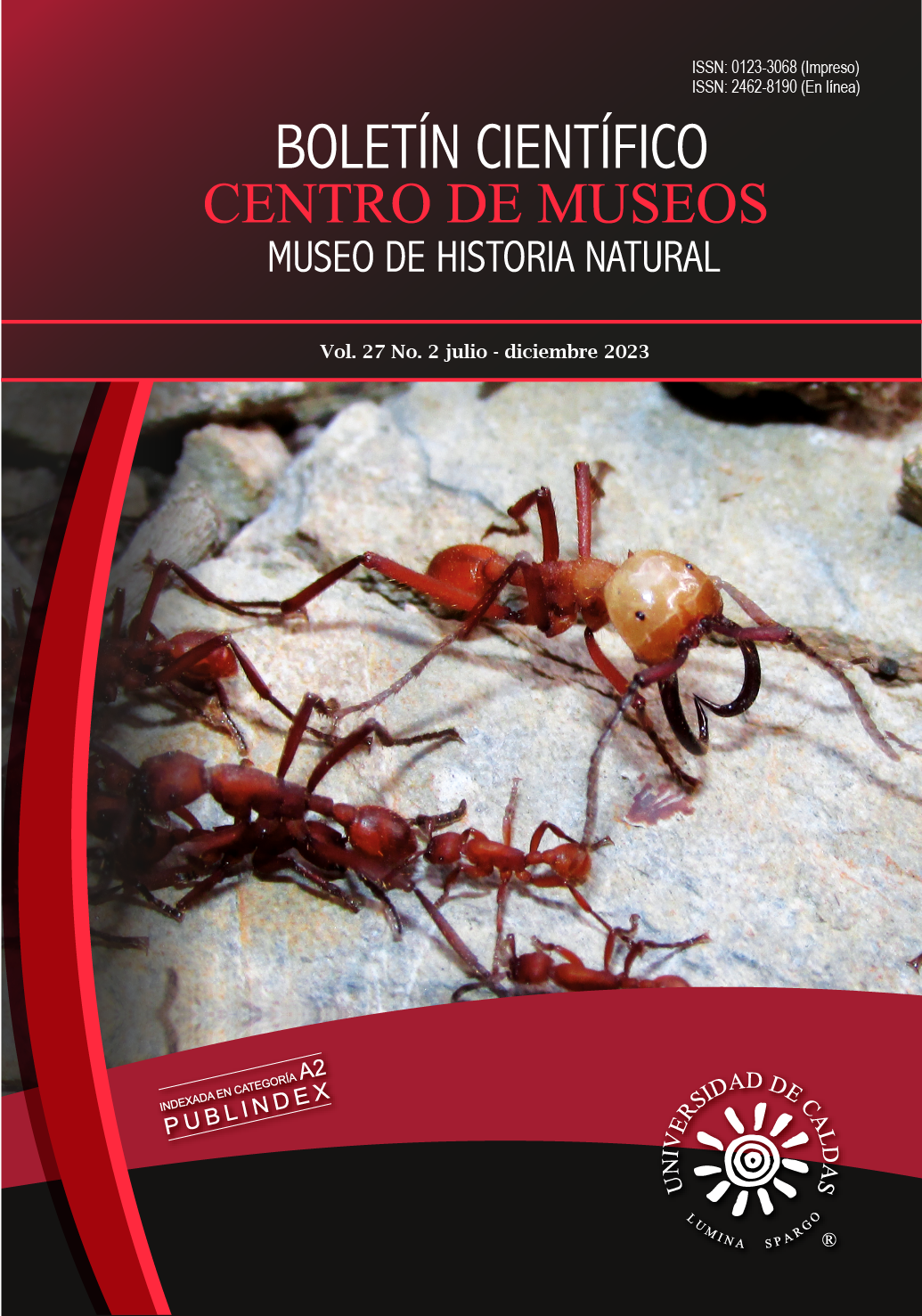Authors
Abstract
Objective: To isolate and identify the major phytosterols present in the plant species Ipomoea trifida through different chromatographic techniques, nuclear magnetic resonance (NMR) spectroscopic techniques and mass spectrometry (MS). Methodology: The aerial parts of Ipomoea trifida were collected in La Concha, municipality of Circasia, Colombia. Then, they were dried, pulverized and macerated with hexane for fractionation and purification of two major sterols by column chromatography. The structures were elucidated by NMR and mass spectrometry techniques. Results: The spectra of NMR-1 H, NMR-13C and DEPT 135, COSY, HSQC and mass spectrometry showed characteristic signals of phytosterols, β-sitosteryl acetate and dihydrolanosterol, being the first report for this plant species. Conclusion: Two major phytosterols, β-sitosteryl acetate and dihydrolanosterol, were isolated and identified for the first time in the hexane extract of the plant species Ipomoea trifida collected in the department of Quindío, as amorphous solids, using spectroscopic techniques that allowed determining the presence of the pentanoperhydrophenanthrene nucleus, the acetate and hydroxyl groups at position 3 for each of them and the side chain at position 17.
Keywords:
References
Bohlmann, F. y Zdero, C. (1982). Germacrene derivatives and other sesquiterpenes from senecio species and Lordhowea insularis. Phytochemistry, 21(10), 2537-2541.
Cabrera, G. M. y Seldes, A. M. (1995). Hydroperoxycycloartanes from tillandsia recurvata. J. Nat. Prod., 58(12), 1920-1924.
Castañeda-Gómez, J., Lavias-Hernández, P., Fragoso-Serrano, M., Lorence, A. y Pereda-Miranda, R. (2019). Acylsugar diversity in the resin glycosides from Ipomoea tricolor seeds as chemosensitizers in breast cancer cells. Phytochem., 32, 77-82.
Da Silva, R., Busch, C., Castro, A., Bicas, J., María, G. y Marostica, M. (2015). Phytosterols: biological effects and mechanisms of hypocholesterolemic action. In: Biotechnology of bioactive compounds: sources and applications. John Wiley & Sons, Ltd. (chapter 23, pp. 565-581).
Farines, M., Cocallemen, S. y Soulier, J. (1988). Triterpene Alcohols, 4-Methylsterols and 4-Desmethylsterols of Eggplant Seed Oil. a New Phytosterol. Lipids, 23(4), 349-354.
Fernández, C., Martín, M., Gómez-Coronado, D. y Lasunción, M. A. (2003). Efecto de los fitosteroles sobre la biosíntesis de colesterol y la proliferación en células humanas. Clin Invest Arterioscl., 15(5), 175-183.
Gómez, A. A. y Rivera, P. H. (1987). Descripción de malezas en plantaciones de café. Cenicafé. Chinchiná (Colombia).
Instituto de Ciencias Naturales (ICN). Online Scientific Collections. Universidad Nacional de Colombia. http://www.biovirtual.unal.edu.co/es/
Itoh, T., Jeong, T. M., Hirano, Y., Tamura T. y Matsumoto, T. (1977). Occurrence of lanosterol and lanostenol in seeds of red pepper (Capsicun annuun). Steroids, 29(5), 569-577.
Kaminaga, T., Yasukawa, K. y Takido, M. (1996). Inhibitory Effect of Poria cocos on 12-0-Tetradecanoylphorbol-13-AcetateInduced Ear Oedema and lbmour Promotion in Mouse Skin. Phytoterapy research, 10, 581-584.
Lira-Ricárdez, J., Pereda-Miranda, R., Castañeda-Gómez, J., Fragoso-Serrano, M., Simas, R.C. y Leitão, S.G. (2019). Resin glycosides from the roots of Operculina macrocarpa (Brazilian jalap) with purgative activity. J. Nat. Prod., 82, 1664-1677. https://doi.org/10.1021/acs.jnatprod.9b00222.
Lu, Y., Sun, J., Yang, Z., Zhao, C., Zhu, M., M. A., D. (2018). Genome-wide identification and expression analysis of glycine-rich RNA-binding protein family in sweet potato wild relative Ipomoea trifida. Gene, 686, 177-86.
Munro, H. D. y Musgrave, O. C. (1971), Extractives from Sporophores of Some Fomes Species. J. Chem. Soc. (C), 685-688.
Nes, W. D. y Nichols, S. D. (2006). Phytosterol biosynthesis pathway in Mortierella alpina. Phytochemistry, 67, 1716-1721.
Osorio, N., Charry, P. A., Ríos-Vásquez, E. y Castañeda-Gómez, J. (2018). Ácidos orgánicos constitutivos de las resinas glicosídicas de tres especies de Ipomoea (convolvulaceae). Revista ion, 31(1), 55-58.
Pereda-Miranda, R., Rosas-Ramírez, D. y Castañeda-Gómez, J. (2010). Progress in the chemistry of organic natural products. Kinghorn AD, Falk H, Kobayashi J. 77-152.
Salinas, l. M., Balseiro, A., Jirón, W., Peralta, A., Muñoz, D., Fajardo, J., Gayo, E., Martínez, I. Z., Riet-Correa, F., Gardner, D. R. y García-Marín, J. F. (2019). Neurological syndrome in goats associated with Ipomoea trifida and Ipomoea carnea containing calystegines. Toxicon, 157, 8-11.
Sharma, M. C., Ohira, T. y Yatagai, M. (1993). Sericeol, a cycloartane triterpene from Neolitsea sericea. Phytochemistry, 33(3), 721-722.
Sharma, M.C., Ohira, T. y Yatagai, M. (1994). Lanostane triterpenes from the bark of Neolitsea sericea. Phytochemistry, 37(1), 201-203.
Swainston, N., Smallbone, K., Hefzi, H., Dobson, P., Brewer, J., Hanscho, M., Zielinski, D., Siong-Ang, K., Gardiner, N., Gutierrez, J., Kyriakopoulos, S., Lakshmanan, M., Li, S., Liu, J., Martinez, V., Orellana, C., Quek, L., Thomas, A., Zanghellini, J., Borth, N., Lee, D., Nielsen, L., Kell, D., Lewis, N., Mendes P. (2016). Recon 2.2: from reconstruction to model of human metabolism. Metabolomics, 12, 109.
Tsopmo, A. y Kamnaing, P. (2011). Terpenoids constituents of Euphorbia sapinii. Phytochemistry Letters, 4, 218-221.
Velásquez-Méndez, A. M., Reyes-Trejo, B., Álvarez-Moctezuma, J. G. y Rodríguez-de la O, J. L. Efecto hipoglucémico de extractos de Acrocomia mexicana en ratas Wistar. Rev. Mex. Cienc. Farm., 44(1), 39-44.
Yasukawa, K., Akihisa, T., Kanno, H., Kaminaga, T., Izumida, M., Sakoh, T., Tamura, T. y Takido, M. (1996). Inhibitory effects of sterols isolated from Chlorella vulgaris on 12-O-tetradecanoylphorbol-13-acetate-Induced Inflammation and Tumor Promotion in Mouse Skin. Biol. Pharm. Bull., 19(4), 573-576.
Yasuo K, T. T. y Katsuyuki, K. (2000). Sporophytic self-incompatibility in Ipomoea trifida, a close relative of sweet potato. Annals of Botany, 85,191.
Yhu-Bi, Z., Run-Rong, Y., Xue-Feng, L., Peng-Cheng, L., Shi-Bing, Y., Peng-Peng, Y., Chang-Xian, Z. y Min, P. (2009). GC–MS analysis of liposoluble constituents from the stems of Cynomorium songaricum. Journal of Pharmaceutical and Biomedical Analysis, 49, 1097-1100.
Zheng, W.F., Cui, Z. y Zhu, Q. (1998). Cytotoxicity and Antiviral Activity of the Compounds from Euphorbia kansui. Planta Med., 64, 754-756.

 PDF (Español)
PDF (Español)
 FLIP
FLIP
 Perfil Google Scholar
Perfil Google Scholar



















